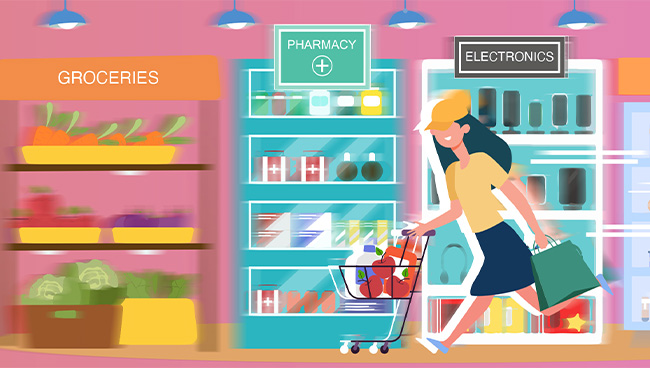People have emerged from their COVID cocoons, and this presents retailers with an unparalleled opportunity to reacquaint themselves. Here is how retailers can alter their foundations to support the accelerated expectations of more tech-enabled shoppers, who think online first and trip to the store second.
Have You Met the 2021 Shopper? She’s the Same, But Faster.
The events of the pandemic have changed shopping behavior in many ways, but customers still want many of the same experiences from retail that they had before 2020: Seamless purchasing, stress-free environments and ease.
Indeed, 58% of consumers wanted quicker trips for the basics two years ago. The pandemic just gave them more reason to get out of the store faster, and retailers obliged by accelerating curbside pickup, contactless checkout, Instacart deliveries and other tech services. More people who thought they couldn’t use these tools adapted, and retailers scrambled to expand them to more stores.
And surprise! Retailers got it right and more shoppers now have more paths to purchase.
As Steve Sadove, the former CEO of Saks Inc. and advisor to Mastercard told WSL Strategic Retail’s CEO Wendy Liebmann in our recent Future Shop podcast, “Retail After the Splurge”: “A lot of things that happened during the pandemic really set the stage for the longer-term.”
5 Ways Retailers Can Show Their ‘New’ Selves
Now that consumers have adapted to new practices during the pandemic, they expect certain old retail practices to be replaced with better ones. Following are five updates retailers simply cannot afford to ignore following the pandemic-induced shopping splurge.
1: Use shopper data and insights to personalize and engage with relevance.
Today one shopper will seem like many – ordering online for some trips and going into the store for others, for example. The data will help retailers follow the same shopper on many paths, and anticipate where the path leads in order to tailor the experience. If they send relevant messages that present well-timed opportunities, shoppers will return. If not, shoppers will tune them out.
2: Improve the supply chain. The supply chain can no longer stop at placement on the shelf.
Retailers need to use fulfillment as an opportunity to enhance the shopper experience from start to finish, by using inventory more efficiently, shortening lead times and customizing the offerings to be more personalized, rather than commoditized. In addition to the right product and place, it has to be the right experience – timely and satisfying.
3: Build stronger relationships in the mobile-first world, including seamless payment methods.
Thanks to mobile technology, 60% of online consumers pre-shop before they buy. This places more importance on digital tools, including reminders to buy, quick access to reviews, alerts to coupons or sales – even an explanation of ingredients. And let’s not forget shoppers are channel-agnostic; merchants should blend the digital experience into the physical store, making them seamless.
4: Enter the new, broader marketplace.
Department stores are selling toys again and electronics chains are offering luggage to fulfill more shopper needs and ease the trip. This presents more opportunities to enrich online options. Look at Walmart.com and Amazon: Each is a marketplace for a variety of brands, creating an array of “stores” in one endless aisle. If Walmart can sell dinnerware by Gap Inc., couldn’t an online pet store sell exercise trackers for dog walkers?
5: Together, these advancements will help enable a faster, easier total experience.
But retailers have to continually monitor customer behaviors to keep abreast of, and satisfy, their preferences. All stores have an opportunity to reintroduce themselves to the customer and change old perceptions of what a drug store, supermarket, department store or dollar store could be.
And those perceptions are evolving even as you read this. Let’s not mistake the pandemic for a catalyst of change that otherwise never would have occurred. It just sped the change up. The retail evolution is never done, and now it moves at a faster pace. As soon as one level of expectations is satisfied, new ones emerge.
Want to hear more about Retail After the Splurge? WSL members can listen to Wendy Liebmann’s Future Shop podcast with Steve Sadove, the former CEO of Saks Inc. and advisor to Mastercard, here.


